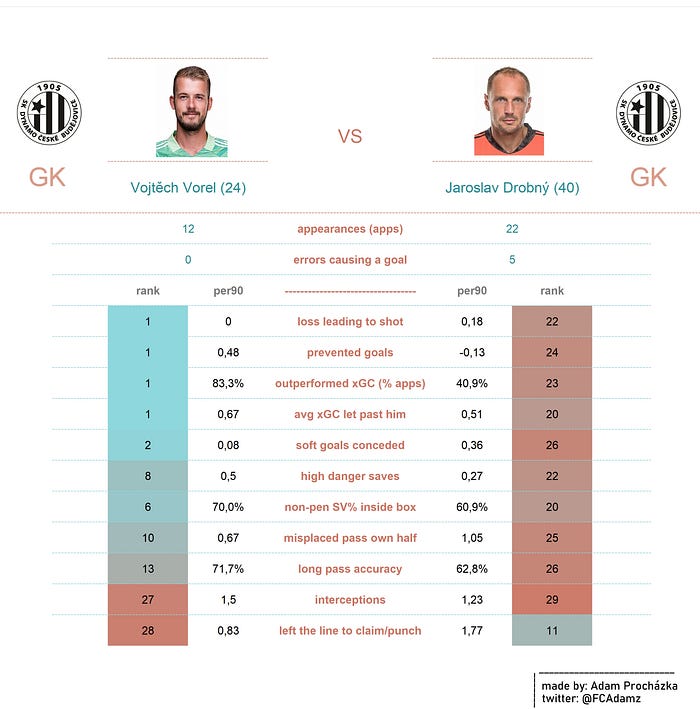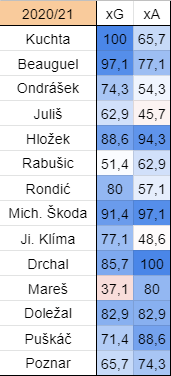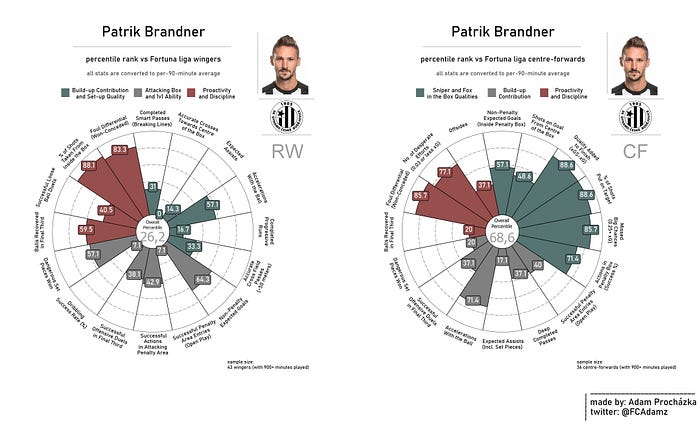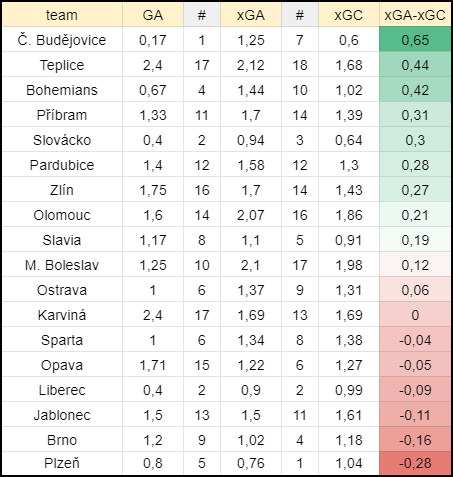2021/22 team preview: SK Dynamo České Budějovice

We are heading down the wire. The last bundle is random and doesn’t really have a theme. Clubs hailing from České Budějovice and Teplice are almost automatically the sole representatives of their regions, so it makes sense they are here, while Zlín do have a local derby with Slovácko, but don’t have the “UEFA competition participant” tag…
Dynamo are a tough, awkward club to evaluate in the grand scheme of things.
On the one hand, it makes sense to wonder whether they aren’t actually one of the biggest underachievers over a span of the past few decades. Only once, after all, have they even landed in the top half of the table (8th in 2003/04) since the club’s general manager Martin Vozábal first took the senior field back in 1996/97 together with a few teenagers you may not immediately place in Č. Budějovice like Stanislav Vlček, Erich Brabec or Roman Lengyel.
On the other hand, it was still absolutely ridiculous to see a Dynamo stakeholder come out firing in March 15, threatening to “act if something doesn’t improve” due to a mildly concerning 5-game winless run which was immediately following up on — and partially overlapping with — a 6-game unbeaten run that included a club record-setting stretch without conceding.
I guess appetite does indeed come with eating.
So who are SK Dynamo České Budějovice? Above all, it’s a club run by smart, visionary people who care for women’s football in a country where it’s still not automatic/fashionable, duly take advantage of virtually bordering one of the best football brands (organizing regular visits to nearby Red Bull training grounds for kids as well as their coaches), regularly take part in world-class youth tournaments over in Germany and invest heavily in data analysis.
That’s all you need to know about them, really, to grow fond of them…
Looking back on 2020/21
What went (particularly) right
That remarkable run of four straight clean sheets actually came on the back of some tremendous luck, but it’s still a run no one’s ever taking away from Vojtěch Vorel, Jaroslav Drobný and the rest of the team in front of them. It’s also a run that virtually saved Dynamo from relegation with more than 10 rounds to spare; late in February, they were 9th with 16 points on M. Boleslav. That’s no small feat for a club that only got promoted two years ago. This is important to always keep in mind here: current České Budějovice are punching above their weight if anything, and their perfect newcoming 2019/20 season of a record 13 victories shouldn’t make us lose perspective.
What went (especially) wrong
That 5-game winless streak referenced above actually turned into an 11-game one. By the end of it, the talk about coach David Horejš’s departure was loud and clear; something that indeed felt inevitable even to some people around the club. Only back-to-back May triumphs over Příbram and Pardubice saved his ass, but it was still an ugly finish. Only three teams sported a worse offence per rolling xG over the last 10 rounds, and just four sides had a worse defence. Over the whole season, no other penalty box got penetrated more often than Dynamo’s, and it was particularly brutal on the road where their opponents, on average, completed a staggering 18,47 crosses/passes in(to) these areas. That number only beats Příbram’s number, and Příbram were awful yknow.
Most valuable player
Look, it’s no secret he doesn’t particularly care for defending. It’s not even a secret he scored 5 of his 8 goals from penalties, already putting him 2nd on the historic club chart of successful penalty takes behind Rudolf Otepka (7). But that doesn’t make Benjamin Čolić any less valuable and, frankly, any less of a mini-phenomenon worth appreciating way beyond České Budějovice.
Per CSfotbal’s expected points added model, if you took all his goals away, you’d be taking 5,19 points away with them. Deduct the four assists of his, as well, and you immediately have Dynamo kicking and screaming — scrambling for survival. His 8 official Team of the Week nominations are inflated by his spot kick performance a great deal, for sure, as are his 5 MotM honours from Deník Sport (on par with Sima and Hložek, by the way), but I mean…
- Benjamin Čolić alone is responsible for 71 successful penalty area entries from open play. Only Dočkal (95) and Ba Loua (74) beat him league-wide and Matej Mršić is his closest rival on his own team — with a “measly” 37;
- Benjamin Čolić completed a total of 46 deep crosses; Lukáš Skovajsa and Pavel Novák — fellow fullbacks ranking 2nd and 3rd on the team — combined for 32;
Those are some insane separations.
And honestly? Screw defence when your presence is felt this strongly upfront.

Chip on the shoulder
Second on my MVP leaderboard was Vojtěch Vorel — a great achievement for someone who wasn’t even a first-choice goalkeeper for most of the season. My MVP model doesn’t work on the per-90-minutes basis, so Vorel is vastly limited by his 12 starts. But only in theory; in reality it was no biggie for him.
Vorel’s average Deník Sport mark of 6/10 puts him in the top echalon of Fortuna:Liga goalkeepers, as do 5,7 prevented goals, yet no one seemed to really take note. Maybe it’s his awkward pedigree; this, after all, was his first Czech top flight season at the age of 25. He’s therefore neither particularly young nor adequately experienced. He’s a loanee yet not quite — poised to spend the season after this one in the South Bohemian city, as well. So odd.
And now the club brings in David Šípoš — a highly-touted 22-year-old — to rival you after you couldn’t be more convincing, more deserving of a bigger role:

Inside the club’s off-season
with much thanks to @t_srajer for helping me around with the write-up
Squad turnover
The Dame Diop saga is over: his visa issue proved to be too complicated for Dynamo to care anymore. That subtracts an extra 537 minutes from the total of 2020/21 playing time, costing Č. Budějovice 72,6% of it when all put together. That’s a navigable amount, but not an ideal one. There’s a case to be made for Drobný already being more of a liability in his last season, but he and Filip Havelka still fit in their most used XI, with both Marko Alvir (13th) and Karol Mészáros (14th) falling just outside of it. At least they weren’t all that productive together, with Mészáros taking most points (4) with him.
Biggest addition
Even if their apparent flirting with the likes of David Houska and Vilém Fendrich didn’t eventually fetch a signature, there was still plenty to choose from as Dynamo worked well towards doubling most positions. Patrik Hellebrand brings some desperately lacking flair to central midfield, Jakub Hora and Ondřej Mihálik some positional flexibility below the striker, and that’d be Michal Škoda — quite plausibly the more effective Škoda next term.
I feel like the less celebrated Škoda doesn’t get enough credit for his hold-up, link-up and, well, general play. Sure, you can always point to his limited mobility and plenty of missed sitters to bash him, but if you as a coach focus on building around him — ie. surrounding him with capable scorers he can lay-off balls for — you’re potentially getting yourself a true difference-maker.

Michal Škoda set his personal best in points last term (14), and it was no accident either, with him eventually landing in the top 10 percentile in both expected non-penalty goals from inside the box and expected assists. I can’t stress how extremely rare this is. On the left, I’ve filtered some of the most complex centre forwards, so you can see them all trying to be Škoda and largely failing at it.
Unless some steep decline is on the horizon for Škoda, I believe Dynamo will soon feel blessed by his 2-year presence. And the fact he’s coming to replace Ledecký and Diop who did fuck all between them makes this a win already.
Greatest subtraction
When the loan deals of Pavel Šulc and Mick Van Buren ended both at once in winter, it proved to be a big blow to Dynamo’s offence — and one the team had never truly recovered from — but it’s hard to go back to those subtractions now, over six months later (or a gazillion months in the Covid language).
If we limit our options to summer departures, then, you get a few decent shouts but none of them quite deducting enough value to particularly matter.
Alvir started off well but faded away rather dramatically towards the end. Havelka is a decent if unspectacular holding midfielder, and that’s about it. Karol Mészáros showed great appetite for hardly defendable runs in behind the line, but injuries limited him to just 14,47 full starts and he didn’t grade out as even above average in any of advanced metrics. In other words, Dynamo have done well to keep (essential parts of) the band together.
New kid on the block
Dynamo were testing out two U-19 players — one of them being Ondřej Novák (b. 2004) and the other one bearing a familiar name of Dominik Mašek (b. 2002). To a significant relief of all potentially confused tweeters like me, though, their proper A-team inclusion seems to have been put on hold for now.
That also narrows our scope greatly. Former wonderkid and Juventus prospect Nikolas Penner is currently training with Dynamo, but his potential return to the club his late father Miloslav spent most time at has yet to be finalized, so we can’t highlight him here. Hence, the new kid on the block has got to be Patrik Hellebrand, even if I usually look to avoid loanees in this section.
But the Slavia player is hard to resist for one particular reason: at Dynamo, Hellebrand has mostly filled a deeper role than at previous clubs, genuinely acting as the last midfielder — a regista of sorts. And it’s worked a treat, apparently, especially when combining with Mihálik and Čolić on the right.
Looking ahead to 2021/22
Below is the team’s current depth chart with a maximum of 4 alternatives for one position. All depth charts are up to date as of July 18 and obviously subject to change since the transfer window is far from closed at the moment. Players highlighted in red are longterm absentees (due to return in months rather than weeks), while players in italics are not confirmed but very likely arrivals. Those likely to depart will be highlighted in the text below, as will some other depth options. To add a little flavour to the depth chart, I’ve intuitively ranked various positions/areas of the pitch — goal, right flank, left flank, central defence, central midfield, forward positions (incl. attacking midfielders) — league-wide from 1 to 15, which is what the different shading (from blue to red) demonstrates.

- Emmanuel Tolno — a direct winger capable of playing on the right as well as on the left — is missing from the depth chart because a visa issue not dissimilar to the one of Dame Diop was complicating his actual arrival. He couldn’t join up with the rest of the team in Austria for the crucial training camp and stayed behind in the Czech Republic, but was finally signed on July 20. Let’s see how much he features early on given the training deficit;
- The central midfield doesn’t inspire too much confidence in me, but if pre-season is to be trusted, Hellebrand finally looks ready to take on more responsibility and move towards fulfilling his potential, so his breakout alone definitely breaks Dynamo’s CM depth out of their 13th rank;
- Speaking of Hellebrand, he was mostly written by the official Dynamo website as a left central midfielder but proved more effective when building plays from the right, so look for him and Patrik Čavoš to swap places;
- The usage of Martin Sladký is a question mark even for most Dynamo fans — he can play further up the pitch (used sparingly in central midfield by Látal at Olomouc) or switch to the left side as a right-footed fullback, too. He’s a bit of a Pavel Novák at that, so let’s see where he slots in eventually;
- Dynamo achieved a peculiar feat in 2020/21: despite having one of FB monsters re. possession-adjusted interceptions in Lukáš Skovajsa (90,7 percentile), they leaked the 2nd most xG from positional attacks down his flank. At the same time — despite having one of the more dangerous dribblers in Mršić — they also generated the 2nd least xG from positional attacks down the left. They just had nothing going for them, seemingly, but it might be something else: Mršić simply started to drift inwards and attack centrally more often than in 2019/20 and especially 2018/19;
- Pay close attention to Ondřej Mihálik who chose to take a step back in order to, hopefully, take two steps forward. He wasn’t getting the desired calls down the middle at Plzeň, and he may not be getting them here either, but he’ll always be relied on when it comes to sneaking in behind the line, because no one else (bar Fortune Bassey, perhaps, if he stays healthy) seems truly capable of providing that among this forward crop.
Statistical/tactical trend to follow
As part of my mid-season review, I put Patrik Brandner forward as my provisional MVP while issuing a warning at the same time: Brandner was also prolific in autumn 2019 (5+3), only to add his last assist in February and barely finish as a 10-point player. Now it was even worse following an even better first part of the season, with Brandner adding just one goal to his familiar 5+3 autumn resumé.
What is going there? Is he simply too exhausted ahead of spring given his energetic style? Does he always visit a witch-doctor at Christmas…?
Truth be told, his poor 2021 spring point returns were to be expected given the departure of Van Buren and the sudden need for Brandner on the right wing. That’s because he’s simply way more effective up top, in a free-roaming centre forward role where he gets to sell his superior fox in the box instincts.

Isn’t that just fascinating? A fine striker, but a below-average winger?
Looking ahead, 2021/22 is going to be just as fascinating. On the one hand, Brandner is going to play more as a winger than a centre forward — that seems to be nailed-on — but on the other hand, he’s never played with an elite target man, so maybe Škoda will feed him in those positions anyway.
As for a team statistical trend to follow, it must be the shot-blocking phenomenon. Dynamo led the league in shots blocked in each season following the promotion, and their records were basically identical (3,74 blocks per game vs 3,73), just the other teams couldn’t catch up in 2020/21 way more than in 2019/20 — with Příbram only other side averaging over 3.
Now, to be clear, this is not to celebrate Dynamo, because in football you can apply the same logic Kent Wilson, one ice hockey writer, applied when coying the immortal quote: “Blocking shots is like killing rats. Doing it is preferable to not, but if you’re doing it all the time, it suggests you have a bigger problem.”
And České Budějovice did have a bigger problem of consistently allowing too many real high-danger shots that just weren’t going in at one point. As I wrote in Patreon Newsletter #2 (February 26) at the tail end of their clean sheet run:
Since returning to action in January, Č. Budějovice have on average allowed opponents to enter their penalty area successfully 12,83 times per 90 minutes. For the sake of comparison: in the case of Slovácko — who’ve also won 4 games — the average reads 6,2. That’s more than a double for Dynamo, while facing a similarly strong/weak competition.
At the same time, Dynamo’s opponents don’t do nearly enough damage when in the penalty area. That’s partially on the formidable blocking brigade as 6 (!) goalbound shots carrying a value of 0,1+ xG never found their way to Drobný/Vorel, but in most part it’s on the shooters who fired off target a ridiculous 18 times from danger areas alone (ie. centre of the box).
Across 6 games, that makes for an average of 3 shots fired wide or over from a decent position, which definitely won’t last. For context, see the table below where Č. Budějovice appear to be the luckiest side by far, benefitting from a series of some serious misfiring.

To explain what you’re looking at here: very generally speaking, while Plzeň have been on the receiving end of some above average finishing, Č. Budějovice have benefitted from some incredible wastefulness. In terms of xGA (all shots), they were supposed to concede 7,47 goals. In terms of xGC (only shots on target), they were supposed to concede a mere 3,61 goals. And in real terms, they conceded just 1 (with an xGA value of 0,12 and xGC value of 0,19 — effectively soft goals to allow).
That’s a staggering drop. And since Teplice are that far behind already, it’s clearly an outlier, too.
After all, consider this as my final point: I mentioned above that Č. Budějovice have been outshot in 5 spring games out of 6, and of course they have, since they’ve faced an average of 14 attempts. What I didn’t mention, though, is shots on target themselves which is where they’ve only gotten outshot twice (!) while their goalkeepers have faced an average of 2,83 attempts.
Again, this is weird. And it most certainly won’t continue to be the case for much longer, if at all…
And continue it did not.
Nine games and 18 conceded goals later, Horejš was about to be fired…
Roster battle to follow
Speaking of blocking shots, look at the comparison table below:

Curious, huh? Who would’ve expected all Dynamo centre backs to be elite or at least above average in all of the “last-ditch-defending” stats like blocks and clearances from the centre of the box… who would’ve expected that indeed!
Who starts, though? First of all, a 3-at-the-back formation is an option, too, though it was used just twice in February 2020, once with Čolić as right centre back (heh) and once with those three above — which is when the clean sheet run ended, too, so naturally, this 3-4-2-1 was cursed and all that!
As you can see on the depth chart, České Budějovice have only three senior centre backs on their books (with Novák capable of filling in anywhere across the backline), but they are all reasonably strong options: you have a fierce fan favourite in Lukáš Havel, a noted analytics darling/neutrals’s favourite in Maksym Talovierov (whom I’m not too high on, by the way), and finally the newly appointed captain despite Čavoš not going anywhere, Martin Králik.
Who do you leave out?
Bold prediction
The prediction: Matej Mršić will receive 3+ votes as Foreigner of the Year
The rationale: While this may not sound too bold at first hearing, consider this: Mršić wasn’t called upon by a single voter following his decent 2020/21, whereas the likes of Hromada, Deli, Ndefe did receive one and Mara got 3 (?!). So there’s a precedent for voters looking mostly to bigger clubs who at least vaguely compete for European cups or downright play in them. The only exception to the rule was Pablo González with a well-deserved 3 votes.
That is exactly where I feasibly see Mršić landing. It’s still bold, absolutely, but I’m expecting a mild breakout and a real upturn in point production. The Croatian’s actual downfall in 2020/21 was the underwhelming 2+1 he put up — ie. average of one point for every 720 minutes of playing time earned.

Now that he’s apparently right-footed, too, it’s going to change dramatically.

If you made it here and enjoyed the article, please do consider supporting me and Adam by donating a small amount of money at BuyMeACoffee page. Thanks!
